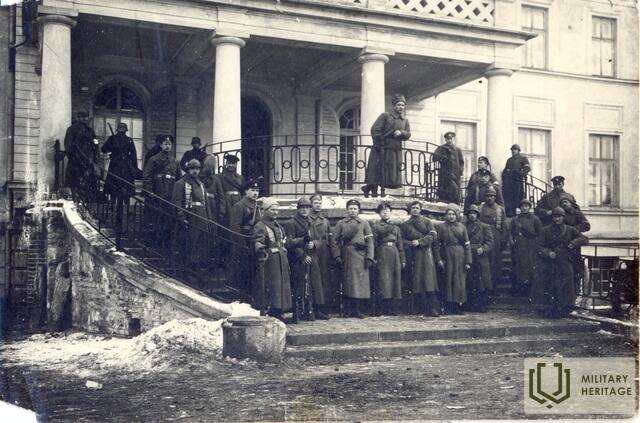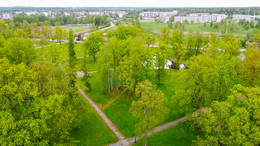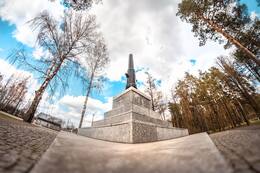Regiment
Independence of the Baltic States, I WW1, I Wars of Independence
A regiment (Latvian: pulks, German: Regiment) is a military unit in the European military tradition, including the Latvian Army.
It was the largest unit of a single weapon class (foot soldiers, mounted infantry or artillery) under the command of a colonel. For tactical tasks, regiments divided into battalions and companies for foot soldiers, division and batteries for artillery, and divisions and squadrons for mounted infantry.
Related timeline
Related objects
Latvian military aviation aerodrome
Located in the territory of Vecgulbene manor - in the historical center.
In the interwar period, the garrison of the Latvian Army was located in Gulbene, where the 7th Sigulda Infantry Regiment Battalion was stationed. Aerodromes are especially important in places where important railway and road junctions have been established. In 1937, a newly established unit of the Aviation Regiment was stationed in Gulbene, which became the 6th Division of the Latgale Division Scouts, increasing the number of army units near the eastern border of Latvia.
The conservatory building is visible.
Monument to the Liberation of Livani
The monument is located at the intersection of Fabrikas and Stacias streets, where it was opened on June 9, 1935 by General Rudolfs Bangerskis, honoring the memory of the soldiers who fell in the battles for the liberation of Lebanon in 1919.
Its main element is a 15-ton, vertically placed cannon barrel. In 1958, the Soviet power dismantled the symbol of the freedom of Lebanon, cutting the barrel of the cannon into scrap metal. The inhabitants of the cannon ball remained throughout the Soviet years, and they returned to their previous place after half a century. The idea of restoring the monument was alive in the people all these years. The Līvāni County Council, together with the residents, was actively involved in the restoration of the monument. Public donations were collected, and on October 3, 2004, the restored Livani Liberation Monument was unveiled in its historic location in the city park.
The inscription on the monument: "Soldiers of the Jelgava infantry regiment fell for Latvia near Līvānii and the liberation of the surrounding area in 1919. Soldiers of the former North Latvian partisan regiment."
The names of soldiers and partisans follow.
Commemorative plaques for the knights of the Lāčplēš War Order in Līvāni district are installed next to it.
The author of the monument was architect Pāvils Dreimanis.
3-5 of 1919 October. Battle of Livani
On October 3, 1919, the big men received a strong blow at the front near Livani. Units of the 3rd Jelgava and 4th Valmiera infantry regiments, as well as units of the Latvian German Land Guard (former Landeswehr) took part in the attack on Līvāni. Units of the 3rd Jelgava Infantry Regiment moved across the Daugava with artillery support. After the successful move, the battles for Livani began, which lasted throughout the day. Around At 17:30, the Livani station was captured, but an hour later the bridges over the Dubna river were crossed. Joint forces managed to expel the bigots from Livani, at At 19:00 the city was completely freed. On October 5, 1919, the big men tried to recover Livani by attacking the new positions of the 3rd Jelgava and 4th Valmiera infantry regiments. The Latvians held their positions with difficulty. This was the first serious and successful attack on the Eastern Front between July and October 1919.
Related stories
7. Formation of Sigulda Infantry Regiment
On June 20, 1919, in the Naukšēni manor, near Rūjiena, the formation of the 7th Sigulda Infantry Regiment was started, according to the order of the Commander of the Northern Latvia Brigade, Colonel Jorgs Zemitans. Initially, a small battle group of 22 officers and 1,580 soldiers was formed from the Northern Latvian Brigade Reserve Battalion, which was named the Danker Division in honor of its first commander, Oskars Dankers. A few days later, the unit was included in the 2nd Battalion of the 3rd Jelgava Regiment, but on August 23, adding to the number of jewelry - in the 7th Sigulda Infantry Regiment.
Liberation of Northern Latgale from the Bolsheviks
On December 1, 1918, parts of the Red Army, based on the Red Rifle units, invaded the territory of Latvia. In order to protect their homes, families, native counties and escape from terror, the men around Balvi took up arms and went into the forests, and the first "green" groups began to form. In the spring of 1919, when the mobilization was announced, many men in the Balvi area were not allowed to fight in the Soviet Latvian army and they joined the "green" groups. Balvi, Silakrog, Rugāji, Teteru-Dūrupe and Liepna groups were formed. In the vicinity of Balvi, the activity of "green" groups became more active in March 1919.









